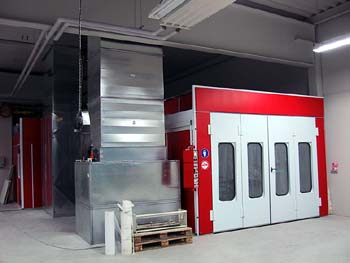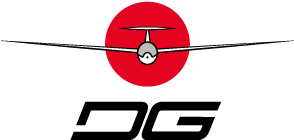For many years the method of painting gliders has changed little. Polyester paint (“Vorgelat”) is sprayed into the open mould and the wings or fuselage are layed up on the wet paint. The “secret” to differing paint quality from different glider manufacturers lies -among others – in the paint factory that supplies the paint.
After the wing or fuselage halves are put together, the joints are cleaned, painted, and sanded with finer and finer paper and finally polished. Independent of the paint used, it is a difficult task that takes years to perfect the skills required.
The result is a very even paint surface because the paint has a certain thickness and the shrinkage of the underlying structure evens it out. Even when the paint is of high quality, it sometimes happens in the course of time that it yellows. It is especially noticeable after re-finishing.
Furthermore the paint can split because of large temperature changes. This is caused by the different coefficients of expansion of the polyester paint and underlying reinforced epoxy plastic.
These cracks and flaking happen mostly due to high altitude flights and can ruin the whole glider surface. Think about how much autos are used and how they stand outside year in and year out, summer and winter, and their paint still looks good. Why don’t we use this type of paint?
The answer is simple: the paint is applied in a thin coat and can’t be sanded afterward. This kind of painting would require a very expensive paint room which is kept very clean and is big enough for a glider wing. An auto paint shop can’t do this, because their paint room is too small!
Otherwise Polyurethane paint offers the very highest quality and is so elastic that it will not crack even if the filler underneath gets hair thin cracks. Even if you don’t leave your valuable glider outside like an auto, the polyurethane paint is without any doubt the better alternative. You will be convinced of this by the continuing high quality of the paint over decades.
DG Flugzeugbau is now in position to deliver the DG-808 and DG-1000 in polyurethane paint. Repairs can be no problem with the paint we use.
We can recommend this paint system without reservation!
We highly recommend completing your glider with a Poly-Urethane (PU) finish!
 One of the features of our new factory is a very expensive, but excellent, Spray Booth. We are now able to apply PU coatings with greater ease and produce an even higher quality finish than before. Because PU is really the best choice and because we are able to apply it flawlessly we have decided to promote PU even more!
One of the features of our new factory is a very expensive, but excellent, Spray Booth. We are now able to apply PU coatings with greater ease and produce an even higher quality finish than before. Because PU is really the best choice and because we are able to apply it flawlessly we have decided to promote PU even more!
We are pleased to offer the PU finish option for about 1,900 Euro additional, a reduction of nearly 50% !
This is the same price as only one finish repair!
In addition, PU is UV-stabilized so your glider will not yellow in the course of time. Naturally, the most important advantage of PU is that, unlike gel coat, it will not crack in the extreme low-temperatures encountered in wave flying. In Northern Italy some pilots have been flying PU-finished gliders for several years in high-altitude wave. There are no cracks in the finish on their aircraft – in contrast to gliders with “standard finish”
What we consider “normal” finish systems were developed two or three decades ago. The “paint-job” on your car today is substantially different than that of the 1970s. It really is not surprising that glider coatings have advanced as well.
Our strong recommendation:
You should order your new glider in PU-Finish.
It really is better, and now it is even more affordable!
Repair Notes
Wilhelm Dirks wrote some short notes how to manage a repair of PUR.
You can download this document.
Recently, we had a visit from an automotive expert in Bruchsal, and he gave us a great many tips for the treatment of various paint finishes. We also talked at great length about the resistance of paint to the effects of weather and chemicals. This automatically led to recommendations about the best care of aircraft finishing coats:
As a rule, you should only ever wash your aircraft with clear water. Using furniture care products as a multi-purpose cleaner of badly soiled surfaces does not do any harm. The same is true for neutral soap. Other cleaners from the automotive trade, however, such as cleaning agents for plastics, cockpit cleaners, bug removers etc., are more problematic because their composition is usually unknown. To be on the safe side, we as manufacturers prohibit the use of such products.
Not to be used are glass cleaner (Perspex is not a glass!), or chemicals such as petrol, oil, antifreeze and brake fluid. Spills of all of these chemicals on any paint surface must be wiped off immediately. The most aggressive agent without any doubt is brake fluid (present in gliders with a disk brake). That damages all paint! (It is true that there are brake fluids on a mineral oil base, but we use the brake fluid recommended by the manufacturers, and unfortunately, that one is highly corrosive on paint.)
Another problem is the tape:
The adhesive remnants can be removed with acetone, or, better, with white spirit. In some cases, especially with cheap tape from the Far East, the adhesive contains the most outrageous ingredients, which may affect even new gel coats. If the paint comes off with the tape when you pull it off, that is usually due to the adhesive used in the tape. You should only use branded tape and stay well clear of cheap special offers. Gel coat repairs cost more money than you will ever be able to save with cheap tape in the entire life of your glider.
Once a year, the aircraft should be cleaned and hard waxed. Large polishing mops are best for that. The traditional Schwabbel buffing wax is still the best choice. There are special products for PU paint finishes, but the usual hard wax is suitable as well.
Many trailers still have no (working) solar generator. All paints have a limited resistance to condensation, i.e. a 100% humidity of air. Glider trailers which are kept outside all the time and therefore get exposed to heat and cold alternately, will inevitably suffer from condensation. This has to be removed by a ventilator. If it is not, small blisters will start to appear in the paint after a few weeks. Needless to say that this is not very good for the metal parts either. Therefore please fit a solar powered ventilator to your trailer it will protect your precious aircraft.
Translation Karin Hulseman
